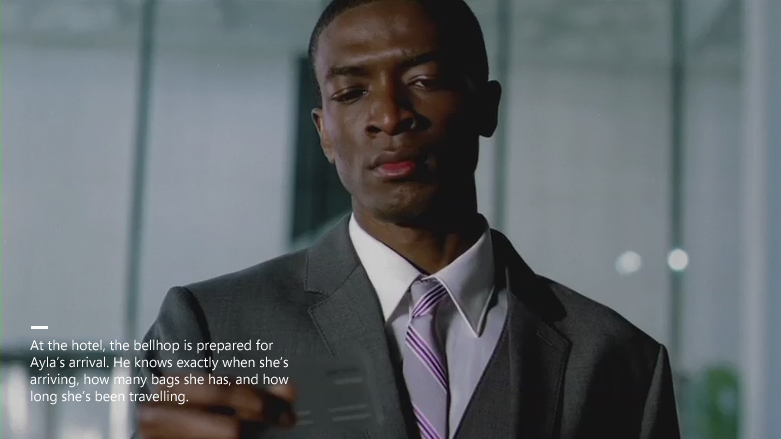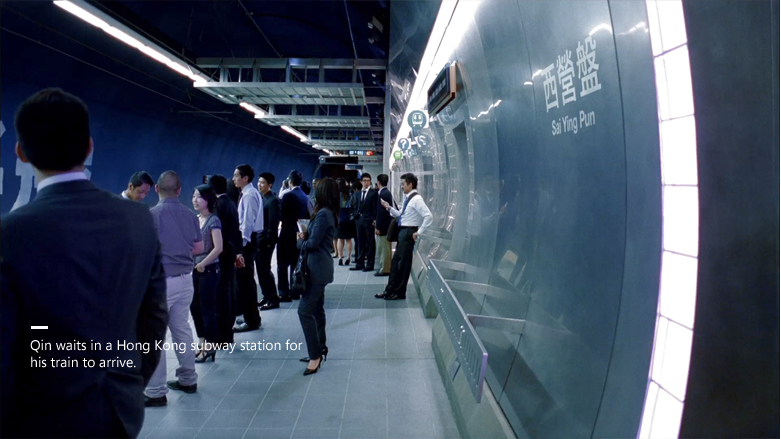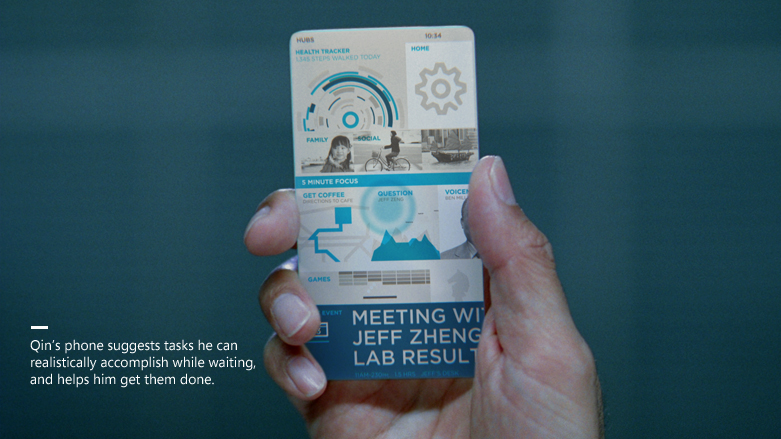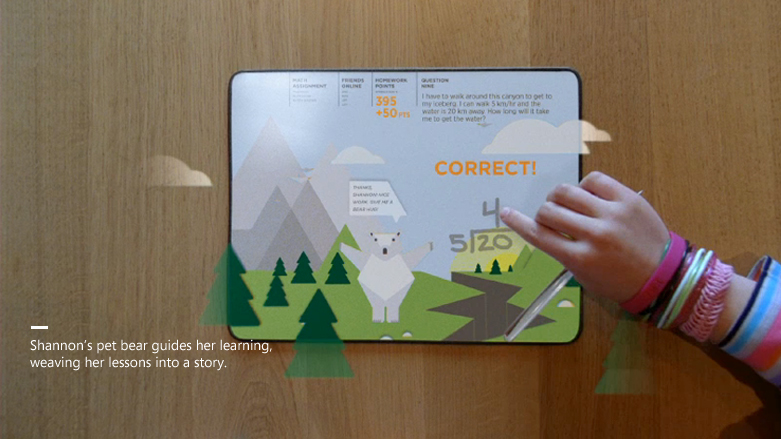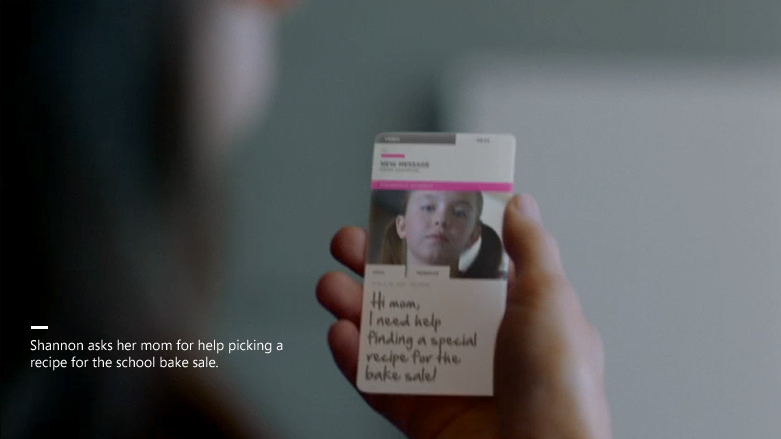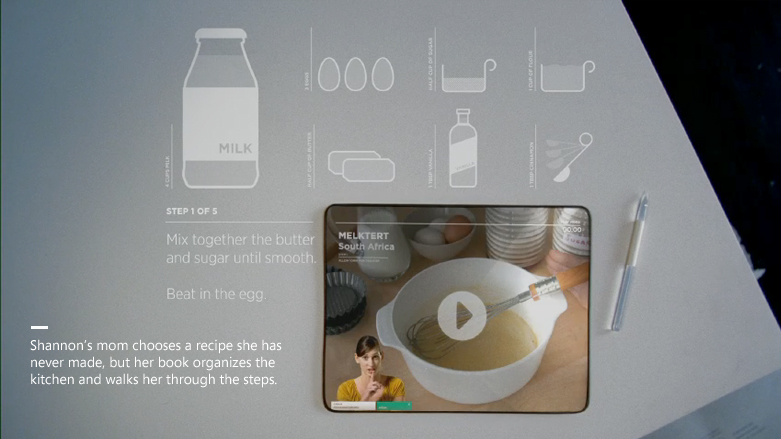This might be as close as we’re going to get to a time machine. Unless they’re working on that, too.
Microsoft this morning is premiering a new video that shows how the company believes technology is poised to evolve over the next five to 10 years, based on the trends its researchers and engineers are seeing in software, devices, displays, sensors, processors and intelligent systems.
It’s a follow-up to the popular “Microsoft 2019” video, developed in 2008 and first shown publicly in 2009. The latest video builds on some of the themes from its predecessor and takes everything further.
As the new video opens, special eyeglasses translate audio into English in real-time for a business traveler in Johannesburg. A thin screen on a car window highlights a passing building to show where her meeting will be the next day, based on information from her calendar. Office workers gesture effortlessly to control and reroute text and charts as the screens around them morph and pulse with new information.
And on and on from there, making our modern-day digital breakthroughs seem like mere baby steps on the road to a far more spectacular future.
The scenes reflect Microsoft’s belief that intelligent systems will bring information to us when we need it, allowing us to work effortlessly across devices and focus on the things we’re trying to do — while keeping us from struggling with or even being conscious of the underlying technology.
[Follow-up: Microsoft’s vision, and the myth of the carefree gadget.]
In this vision of the future world, computers will do more to make us productive, but not just in the traditional sense. They’ll help us use our time more effectively, they’ll focus our attention on what’s important, and let us build stronger relationships with people we care about.
“We see an expanded definition of productivity where it’s not just about getting things done,” said David Jones, Microsoft’s director of envisioning, whose group developed the video. “It’s also about doing the right things, and doing them well and enjoying the process with other people in a very natural way.”
But even if the vision is solid, there’s no guarantee that Microsoft will be the one to make it a reality. That’s a risk for the company. Microsoft has no problem thinking big, but in recent years it has struggled, at times, to turn that vision into leadership, particularly in the consumer market.
[Follow-up: Microsoft marks Kinect’s first year with great video, old data]
For example, futuristic tablet computing was a big focus of the previous video, but it was Apple that would soon come along and make tablets mainstream with the iPad, a decade after Microsoft tried unsuccessfully with its own Windows tablets.
In the same way, elements of Apple’s new Siri intelligent assistant for the iPhone 4S could be seen as a predecessor to some of the futuristic scenes in the latest Microsoft video. (For what it’s worth, the new Microsoft video was in development many months before the Apple product announcement.)
 There’s also a risk that Microsoft might be giving ideas to smaller rivals that could implement elements of its vision more quickly.
There’s also a risk that Microsoft might be giving ideas to smaller rivals that could implement elements of its vision more quickly.
But these videos are more about business technology, where Microsoft Office and Windows remain standards. And the company sees a larger purpose in presenting its long-term vision in this way. Microsoft has historically made these videos to help give its customers, particularly in the corporate world, an idea of how it sees the future, so they can have a better sense of what they might be getting into long term when they make bets on the company’s technology.
The videos can also spark discussion and debate inside the company.
“It’s something to react to and have a conversation around,” said Chris Pratley, Microsoft general manager of technical strategy.
 Jones added, “You can stop any frame in the video and talk for an hour about everything that’s going on. There’s a lot of thinking layered in. We’re trying not to be superficial at all — there’s a lot of deep thinking.”
Jones added, “You can stop any frame in the video and talk for an hour about everything that’s going on. There’s a lot of thinking layered in. We’re trying not to be superficial at all — there’s a lot of deep thinking.”
Pratley explained, “It would be relatively trivial to do a kind of Hollywood thing, where you just say what would be cool, and you whip it up and put it on the screen. But everything in the video, we could footnote everything about where it’s coming from, who’s working on it, why we think it’s going to happen.”
In that spirit, here’s a series of screenshots from the video, with Microsoft’s explanation of what’s happening in each.
